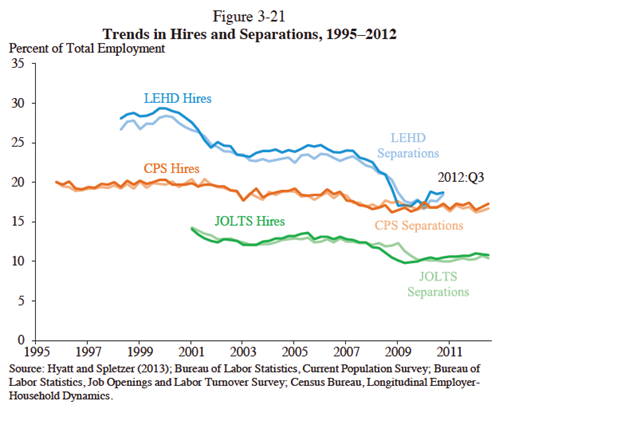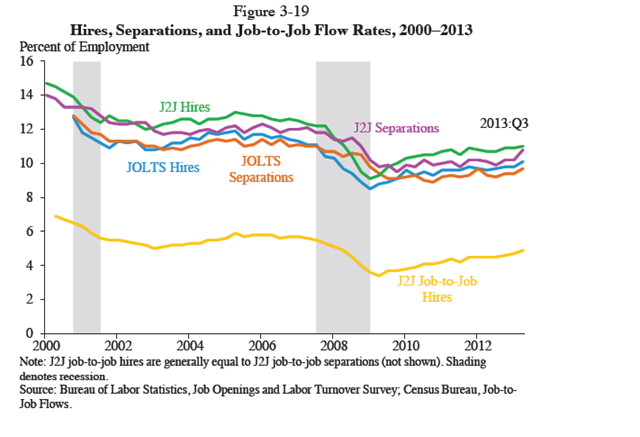The recently released Economic Report of the President (ERP) highlights new public-use data tabulated from LEHD data and several LEHD research papers. The LEHD data and research are used prominently in chapter 3, "Achievements and Challenges in the U.S. Labor Market." Chart 3-21 in the ERP (copied below) shows that there are long-run downward trends in labor market fluidity that date back several decades. Since 1998, hires and separations rates have declined by 38 percent in the LEHD data, with declines of roughly 31 percent in the Job Openings and Labor Turnover Survey (JOLTS) data and 10 percent in the Current Population Survey (CPS) data. Research papers by Henry Hyatt and James Spletzer (2013) and Steve Davis and John Haltiwanger (2014) are cited extensively. While reductions in labor market fluidity might be indicative of more stable jobs which would be a positive development, they might instead reflect less reallocation of resources towards their most productive uses and thus fewer high-paying jobs. On average, earnings gains from job change are substantial -- estimates given in Table 3-3 of the ERP cite gains to switching jobs of 6 to 14 percent for workers aged 25 to 55. These earnings gains are based on LEHD data from a research paper by Bruce Fallick, John Haltiwanger, and Erika McEntarfer (2012).

The newly released public-use Job-to-Job Flows data is also highlighted in Figure 3-19 of the ERP (copied below). Job-to-Job Flows (J2J) is a new statistical product that fills a gap in the set of available labor market statistics, providing statistics on job change as well as flows of workers in and out of employment. It is tabulated from LEHD data, using the longitudinal worker histories to follow workers across jobs. As is evident in Figure 3-19, the J2J shows that the recovery in job separations in recent years is driven by an uptick in workers changing jobs.

The Economic Report of the President details national economic priorities and sets the agenda for economic research needs. By highlighting economic trends revealed by LEHD data, this high-profile recognition for LEHD data and research demonstrates the great value of the LEHD state partnership in revealing many interactions between workers and firms in the U.S. economy that were previously not observable.
Link to the full Economic Report of the President here:
https://obamawhitehouse.archives.gov/sites/default/files/docs/cea_2015_erp_complete.pdf ![]() (4.9 MB).
(4.9 MB).
References:
Council of Economic Advisers (CEA). 2015. "Economic Report of the President."
Davis, Steven and John Haltiwanger, "Labor Market Fluidity and Economic Performance." NBER Working Paper 20479. Available at
http://www.nber.org/papers/w20479  .
.
Hyatt, Henry R., and James Spletzer. 2013. "The Recent Decline in Employment Dynamics." IZA Journal of Labor Economics 2: Article 5. Available at http://www.izajole.com/content/pdf/2193-8997-2-5.pdf ![]() (1.4 MB).
(1.4 MB).




